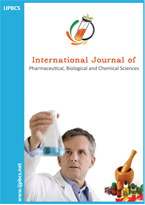MANAGEMENT OF POST-HARVEST FUNGI IN PAPAYA BY PLANT EXTRACTS AND ESSENTIAL OILS
Main Article Content
Abstract
Post-harvest fungal infections represent a major challenge to the storage and marketability of papaya (Carica papaya L.), often causing significant economic losses. This study evaluated the antifungal efficacy of selected aqueous leaf extracts and essential oils against major post-harvest fungal pathogens of papaya using the poisoned food technique. Infected fruits were collected from local markets in Chhatrapati Sambhajinagar and Dharashiv, and fungal isolates were identified based on morphological characteristics. A total of thirteen fungal species, including Alternaria alternata, Aspergillus flavus, Aspergillus fumigatus, Aspergillus niger, Colletotrichum gloeosporioides, Curvularia lunata, Fusarium equiseti, Fusarium moniliforme, Fusarium oxysporum, Penicillium digitatum, Penicillium islandicum, and Rhizopus stolonifer, were tested against seven plant extracts and six essential oils. Among the aqueous extracts, Annona squamosa showed the highest inhibition, particularly against Fusarium oxysporum (83.9 %), while Vitex negundo exhibited strong activity against Colletotrichum gloeosporioides (94.7 %). In contrast, Azadirachta indica and Piper betel extracts demonstrated relatively low efficacy. Essential oils exhibited broad-spectrum antifungal activity, with Ricinus communis (castor oil) being the most effective, showing over 80% inhibition against several fungi. Oils of Brassica juncea, Ocimum sanctum, and Syzygium aromaticum also showed promising results, while Eucalyptus globulus and Azadirachta indica oils were less effective. Statistical analysis confirmed significant differences among treatments (p < 0.05). The results supported the potential of Annona squamosa extract and castor oil as eco-friendly, cost-effective alternatives to synthetic fungicides for managing post-harvest papaya diseases.
Downloads
Article Details

This work is licensed under a Creative Commons Attribution-NonCommercial-ShareAlike 4.0 International License.
How to Cite
References
Atolani, O., Adamu, N., Oguntoye, O., Zubair, M., Fabiyi, O., Oyegoke, R., Adeyemi, O., Areh, E., Tarigha, D., & Kambizi, L. (2020). Chemical characterization, antioxidant, cytotoxicity, Anti-Toxoplasma gondii and antimicrobial potentials of the Citrus sinensis seed oil for sustainable cosmeceutical production. Heliyon, 6(2).
Davy, M., Sameza, M. L., Tchameni, S. N., Ayong, M. N. A., Bedine, M. A. B., Youassi, O. Y., Kamsu, P. N., & Jazet, P. M. D. (2020). Antifungal effects of clove (Syzygium aromaticum) essential oil against Colletotrichum gloeosporioides, the fungus associated with papaya (Carica papaya L.) fruit anthracnose. International Journal of Applied Microbiology and Biotechnology Research, 8, 51-57.
Kabir, M. Y., & Hossain, S. K. (2024). Botanical extracts improve postharvest quality and extend the shelf life of papaya (Carica papaya L. cv. Shahi). New Zealand Journal of Crop and Horticultural Science, 1-17.
Kalidindi, N., Thimmaiah, N. V., Jagadeesh, N. V., Nandeep, R., Swetha, S., & Kalidindi, B. (2015). Antifungal and antioxidant activities of organic and aqueous extracts of Annona squamosa Linn. leaves. Journal of food and drug analysis, 23(4), 795-802.
Leyronas, C., Duffaud, M., & Nicot, P. C. (2012). Compared efficiency of the isolation methods for Botrytis cinerea. Mycology, 3(4), 221-225.
Mahmoud, D., Hassanein, N., Youssef, K., & Abou Zeid, M. (2011). Antifungal activity of different neem leaf extracts and the nimonol against some important human pathogens. Brazilian Journal of Microbiology, 42, 1007-1016.
Makarenkov, V., Boc, A., Xie, J., Peres-Neto, P., Lapointe, F.-J., & Legendre, P. (2010). Weighted bootstrapping: a correction method for assessing the robustness of phylogenetic trees. BMC evolutionary biology, 10, 1-16.
Mugao, L. (2004). Factors influencing yield, chemical composition and efficacy of essential oils. Int. J. Multidiscip. Res. Growth Eval, 5, 169-178.
Nene, Y. L., & Thapliyal, P. N. (1979). Fungicides in plant disease control.
Pathak, V. M., Verma, V. K., Rawat, B. S., Kaur, B., Babu, N., Sharma, A., Dewali, S., Yadav, M., Kumari, R., & Singh, S. (2022). Current status of pesticide effects on environment, human health and it’s eco-friendly management as bioremediation: A comprehensive review. Frontiers in microbiology, 13, 962619.
Prasad, K., & Paul, J. R. (2021). Postharvest losses of papaya and practice for management. Food Sci. Rep, 2(7).
Sarkhosh, A., Schaffer, B., Vargas, A., Palmateer, A., Lopez, P., Soleymani, A., & Farzaneh, M. (2018). Antifungal activity of five plant-extracted essential oils against anthracnose in papaya fruit. Biological Agriculture & Horticulture, 34(1), 18-26.
Silva, A. M. D., Terao, D., Vilela, E. S., Queiroz, S. C. N. D., Maia, A. H., & Fracarolli, J. A. (2025). Essential oils on the control of postharvest diseases of papaya. Anais da Academia Brasileira de Ciências, 97(1), e20240770.
Siqueira Júnior, C. L., Freire, M. d. G. M., Moreira, A. S. N., & Macedo, M. L. R. (2012). Control of papaya fruits anthracnose by essential oil of Ricinus communis. Brazilian Archives of Biology and Technology, 55, 75-80.
Sitara, U., Niaz, I., Naseem, J., & Sultana, N. (2008). Antifungal effect of essential oils on in vitro growth of pathogenic fungi. Pakistan Journal of Botany, 40(1), 409.
Sivareddy, B., Reginald, B. A., Sireesha, D., Samatha, M., Reddy, K. H., & Subrahamanyam, G. (2019). Antifungal activity of solvent extracts of Piper betle and Ocimum sanctum Linn on Candida albicans: An: in vitro: comparative study. Journal of oral and Maxillofacial Pathology, 23(3), 333-337.
